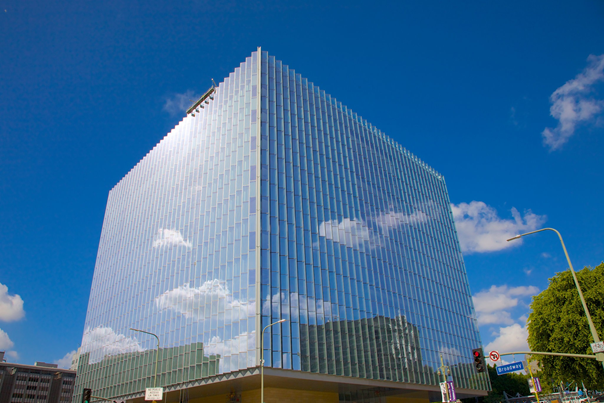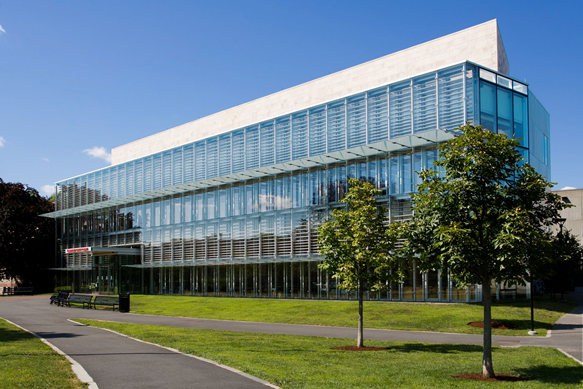An Important Vote for the Climate
Local officials across the country will have a chance to vote on new energy efficiency standards for buildings. But few tend to vote, which could put the outcome in jeopardy.
Mr. Gillis is a contributing opinion writer.
March 20, 2019

An energy-efficient federal courthouse in downtown Los Angeles. CreditCreditBarry Winiker/Photolibrary, via Getty Images
One of the great achievements of politics in the late 19th and early 20th centuries was the spread of effective building codes that made our buildings safer and sturdier, and our cities less likely to burn down.
For the last couple of decades we have been using those building codes for an additional purpose: saving energy. The average house or office building constructed today is required to have better windows and insulation than the drafty old buildings we used to put up, so that a new building wastes far less energy over its lifetime.
Making buildings more efficient not only saves consumers money, it is also crucial in the fight against global warming because it cuts the use of fossil fuels. We are a few months away from an election, of sorts, that could tighten our building codes still further.
But forces are already stirring in the land to make sure this vote goes the wrong way. Those forces may be abetted by low voter turnout, which has been a big problem in the past. If history repeats itself this year, the energy policy of the United States may be influenced by fewer than 500 people.
The technology of buildings continually evolves, creating new ways to save energy. Tightening our building codes regularly is the best way to pull these new techniques into the market. However, building to the latest standards can cost a little extra money, at least initially, so you can probably guess where some of the opposition originates.

A public library in Cambridge, Mass., has an environmentally friendly and energy-efficient design.Credit A.P. Cortizas Jr/E+, via Getty Images
America has no national building code, strictly speaking. States and cities adopt and enforce their own. These local codes tend to be based on a few national model codes put out by several organizations, generally every three years.
One of the most important models is the International Energy Conservation Code, which many American communities use as the template for their energy-saving code provisions. The latest version will be finalized in a round of voting later this year, and most communities will decide in 2020 whether to incorporate it into their own codes.
So in this election, the “candidates” are proposed new standards for how people ought to construct buildings in the United States. Who gets to vote? Basically, the governments that will ultimately decide whether to adopt this code as their own pick representatives to cast ballots. Small towns get a handful of votes while big cities get more. Municipalities tend to nominate representatives with expertise in the subject — say, the heads of their building, fire and planning departments.
In theory, tens of thousands of these municipal officials could vote in the election. But people running busy departments have tended to let this duty fall off their radar, with many of those eligible to vote never signing up to take part. And of those who do sign up, some are chiefly concerned with provisions like fire safety, so they stop voting when they get to the energy provisions.
By now you may be wondering why all this is important. Because when so few people vote, groups opposed to improved building codes can gin up enough no votes to kill important measures — with long-term consequences for all of us. I repeat: This is a central aspect of the energy policy for the entire country, routinely decided by fewer voters than might turn out for a New England town hall.
When the energy codes started, proponents of better buildings made some amazing gains; over the course of two code cycles a decade ago, projected energy use in buildings was cut by more than 30 percent. But the last two times the vote was held, important changes to the model building code were voted down, in some cases by relatively few votes.
And who would be against them? The National Association of Home Builders. This industry group always complains vociferously about requirements like newer window technology or better light fixtures that will drive up builders’ costs by 1 or 2 percent. Of course the buyers of those houses would get the money back in a few short years through lower energy bills, a point the opponents rarely mention.
For the coming election, a coalition of experts focused on building efficiency is aiming for a minimum improvement of 10 percent, and hoping for more. Given how slow the building industry is to change, 10 percent is a big number. The home builders are already organizing to try to block the effort.
So we need our communities to act. In particular, more than 400 American mayors have committed themselves to battling greenhouse emissions. If you are one of them, here is a concrete step: Make sure that your city or county agencies have paid their dues to the International Code Council, the group that runs this election, and that they intend to nominate voting representatives. The deadline to pay the dues is March 29, and if your jurisdiction does not sign up by then, it will not be able to cast votes this fall.
The measures themselves are pretty technical, so how can you tell which are good? Anybody planning to vote on the model code should follow the work of the Energy Efficient Codes Coalition, in Washington, which plans to offer advice on specific measures.
Once an improved model code is out next year, mayors should move to adopt it for their localities as quickly as possible. Yes, the local builders will whine. You can point out to them that we are trying to salvage a livable climate for our children and grandchildren, and we really need their help putting up less wasteful buildings.
The Times is committed to publishing a diversity of letters to the editor. We’d like to hear what you think about this or any of our articles. Here are some tips. And here’s our email: letters@nytimes.com.
« Back to BlogP.O. Box 776
Urbana, Ohio 43078
